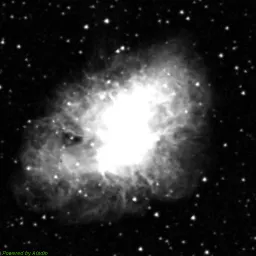Crab Nebula (M1) Observation Details

M1 Daily Motion
M1 will rise at 13:20, reaching 32° when twilight begins at 16:07. It will reach transit at 75° by 20:31 and will set before twilight ends at 03:41.M1 will be visible until April, 28, when it will move too close to the Sun. During this time, its proximity to the Sun will cause it to disappear from the night sky, making it unobservable for a while.
M1 Visibility Timetable on January 08
M1 Rise and Set Timetable
| Time | Elevation | |
| M1 rise | 13:20 | |
| Sunset | 15:04 | 19° |
| Civil sunset | 15:35 | 25° |
| Astrosession begin | 16:39 | 38° |
| Moon Rise, 73.2% illuminated | 20:11 | 74° |
| M1 transit | 20:31 | 75° |
| M1 set | 03:41 | |
| Astrosession end | 03:49 | -1° |
| Moon Set | 08:42 | -31° |
Track M1 Position Throughout the Night
← Thu, 8 January 2026 →
| Time | |
| Altitude | |
| Azimuth |
Where is Crab Nebula right now?
Crab Nebula (M1) is located in the constellation Taurus, at right ascension 05h 34m 31s" and declination 22° 00' 52s. At the current time, it is below the horizon and not visible from your location.M1 - Crab Nebula
The Crab Nebula (M1) is a supernova remnant located in the constellation Taurus. It was first observed by John Bevis in 1731 and later included in Charles Messier's catalog in 1758 as the first entry. The nebula is the result of a supernova explosion recorded by Chinese astronomers in 1054 AD.
Spanning about 11 light-years across, the Crab Nebula is expanding at a rate of approximately 1,500 kilometers per second. At its heart lies the Crab Pulsar, a rapidly rotating neutron star that emits pulses of radiation from gamma rays to radio waves. The pulsar has a rotational period of 33 milliseconds, making it one of the fastest known pulsars.
The nebula's distinctive filamentary structure and colorful appearance are due to the presence of various elements, such as hydrogen, helium, oxygen, carbon, and sulfur. These filaments are remnants of the progenitor star's outer layers that were expelled during the supernova explosion.
Due to its relatively high brightness and well-defined structure, the Crab Nebula is a popular target for both amateur and professional astronomers. Located about 6,500 light-years from Earth, it has an apparent magnitude of 8.4, making it visible through small telescopes.
M1 Image Gallery
DSS Blue

DSS Red

DSS Near-Infrared

DSS Composite image

The photos are taken from the Digitized Sky Survey 2 (DSS2), which was produced at the Space Telescope Science Institute (STScI) under NASA contract, using data from the UK Science and Technology Facilities Council (STFC), the European Southern Observatory (ESO), and the National Geographic Society-Palomar Observatory Sky Survey (POSS II).
Special thanks to the National Optical Astronomy Observatory (NOAO), the Royal Observatory, Edinburgh, and the California Institute of Technology for their significant contributions.
Finder Chart for M1
| Object name | M1 |
| Field of view | |
| Limiting magnitude | |
| M1 coordinates | 5.57555, 22.01447 |
| Center coordinates | 5.57555, 22.01447 |
M1 Passage Through Night
Current position of M1
| Time | 06:02 |
| Latitude | 37.3541 |
| Longitude | -121.955 |
| M1 elevation | -21° |
| M1 Azimuth | 37° |
Annual motion of M1
| Date | Thu, 8 January 2026 |
| Twighlight start | 16:34 |
| Twighlight end | 03:43 |
| Twighlight duration | 11h 9m |
| Rise | 13:20 |
| Set | 03:41 |
| Elevation at transit | 75° |
| Transit time | 20:31 |
| Equatorial coordinates | RA: 05h 34m 31s", Dec: 22° 00' 52s |
| Magnitude | 8 |
| Constellation | Taurus |
The graph is structured with the vertical axis showing the hours of the day, ranging from 12 AM to 12 AM the next day, while the horizontal axis spans each day of the year.
The reddish shaded area indicates the periods when the M1 is above the horizon, visible to observers. The white line marks the times when the celestial object reaches its highest point in the sky each day, known as the transit.
Astrometric & Physical Parameters of M1
Coordinates & Visibility
| Right Ascension | 5.57555° |
| Declination | 22.01447° |
| Magnitude | 8.40 |
| Constellation | Taurus |
| Elevation | -20.8° |
| Azimuth | 37.3° |
Data Credits
The nebulae information on this page is sourced from the OpenNGC project, developed by Matteo Verga. OpenNGC provides detailed data on the NGC catalog, which is a valuable resource for exploring deep-sky objects such as nebulae.
For more details or to contribute to OpenNGC, visit the official GitHub repository: OpenNGC on GitHub.
